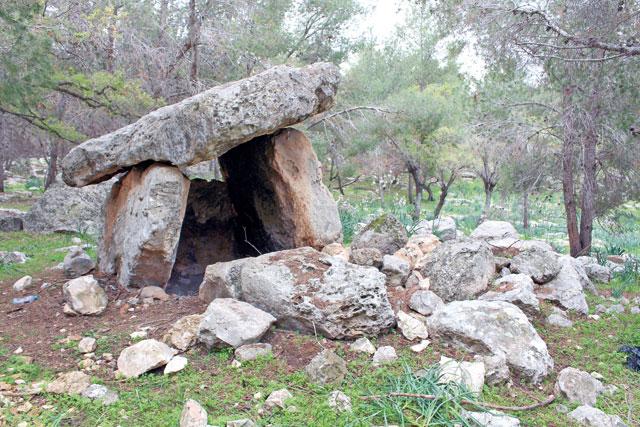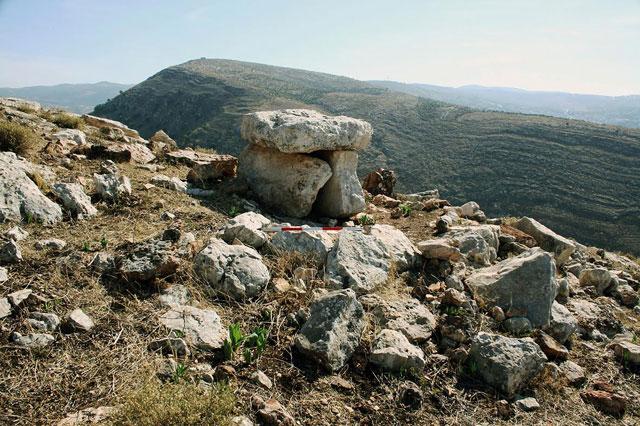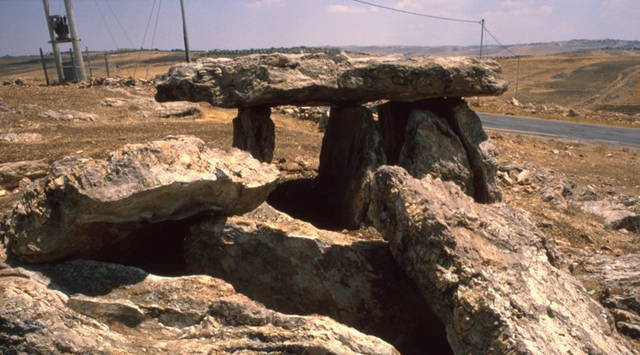You are here
Scholar believes he has answer to Jordan Valley dolmens’ exclusivity
By Saeb Rawashdeh - Jan 10,2019 - Last updated at Jan 10,2019

In this undated photo, a dolmen in Juffein Forest, in Jordan can be seen (Photo courtesy of James Fraser)
AMMAN — Dolmens, above-ground tombs made of giant slabs of stone, are scattered throughout northwest Jordan, but their absence from other areas have perplexed researchers, until recently.
A dolmen is an above-ground, single-chamber megalithic tomb, consisting of two or more vertical megaliths that support a large capstone. Most of the Levant’s dolmens are located on the eastern side of the Jordan Valley.
“Most dolmens are found between the Jaulan Plateau and the Madaba plains,” said Australian archaeologist James Fraser, adding that although some are found west of the Jordan River in the Galilee region, most so-called “dolmens” identified in Israel and occupied Palestine are probably other features built from large stone blocks, but do not resemble the table-like dolmens of Jordan.
The scholar, who received his PhD from the University of Sydney, thinks the dolmens’ regional exclusivity is because of two factors. Firstly, the tradition of dolmen building, 5,000 years ago, was a local tradition and communities that built dolmens did not extend west of the Jordan River.
Secondly, in the east, very hard micro-crystalline geological formations extend all the way down to the Jordan Valley’s edge. In contrast, the hills on the west side of the Jordan Valley are characterised by softer geological formations — at least in the lower elevations where communities lived during the Early Bronze Age.
“Consequently, in areas of hard rock, people built above ground tombs [east of the Jordan River], and in areas of soft rock, people cut tombs into the ground [west of the Jordan River],” Fraser underscored.
Fraser currently directs the Khirbet Ghozlan Excavation Project with the British Museum, investigating Bronze Age olive oil production in Jordan at around 2,000 BC. He also worked at a dolmen site in the Wadi Rayyan area of the Jordan Valley.
The scholar tried to link dolmens, settlements and geology at the Wadi Rayyan site: “I propose that every single dolmen field in Jordan is always found near villages and towns that were occupied in the Early Bronze Age I period [3,700-3,000 BC].”
According to Fraser, the dolmen fields served as cemeteries for these communities.
“Yet, while all dolmens are found near Early Bronze Age I sites, not all Early Bronze Age I sites are found near dolmens. Why not?” he asked.
Geology might be the answer, he continued, noting that “when Early Bronze I sites are located on areas of very hard bedrock, people constructed above-ground tombs, which is the case in the Wadi Rayyan, where dolmens near the modern town of Kufr Abil are surrounded by several village sites on hard limestone bedrock”.
However, no dolmens are found in nearby wadis, such as Wadi Ziqlab or Wadi Yarmouk, Fraser elaborated, “even though these wadis were also occupied at the time”.
“This is because the bedrock in these wadis consists of softer marl and chalk formations so it was far easier for ancient people to cut into these softer rocks to create below-ground chambers,” Fraser explained.
Equalisers, family-based tombs
One dolmen near Tal Al Umayri, on the Madaba Plain, was discovered unrobbed in the 1990s, the researcher said, adding that this dolmen contained the remains of over 20 people.
“The fact that the remains were mixed, and the fact that they appeared to have been interred with very similar burial goods, suggests that they were of the same social class,” Fraser underlined.
However, burials in below-ground tombs at Bab edh-Dhra, near the Dead Sea, contain no evidence to suggest the burial of people from different social classes, he said.
“Instead, people were buried in the same ways and with the same goods, suggesting that burial in fact helped perpetuate an egalitarian society,” Fraser claimed, noting that studies of the teeth enamel and teeth morphology tells researchers that people buried in the same tombs at Bab edh-Dhra were often genetically related, suggesting they were family tombs.
“Did the same processes happen in the dolmens? Although we don’t know for sure, I think that it is very likely.”
Moreover, in large concentrations of dolmens, some dolmens still cluster together like small family tombs, the archaeologist outlined, adding that they appear to have been constructed so that one short end could be temporarily sealed by small rocks or mud, so that people could reopen them to continue to bury family members over a long period of time — perhaps several generations.
“Dolmens are a remarkable part of the rich heritage of Jordan. They show how ancient people were very innovative in how they used their natural environment in their daily lives. Dolmens also show how people shaped the landscape around them,” Fraser said.
“A hillside covered in dolmen tombs would have had special meaning... which probably continued long after the people who constructed the dolmens were dead and forgotten.”
Related Articles
AMMAN — The monumentality of dolmens, or megalithic stone tombs, has always captured the minds of archaeologists, who find them “the most st
AMMAN — There are two typical megalithic structures that can be found in Jordan-dolmens and menhirs. Dolmens are a single-chamber megal
AMMAN — Having survived thousands of years to tell stories about the Kingdom’s early societies, Jordan’s Late Bronze Age dolmens (upright st














